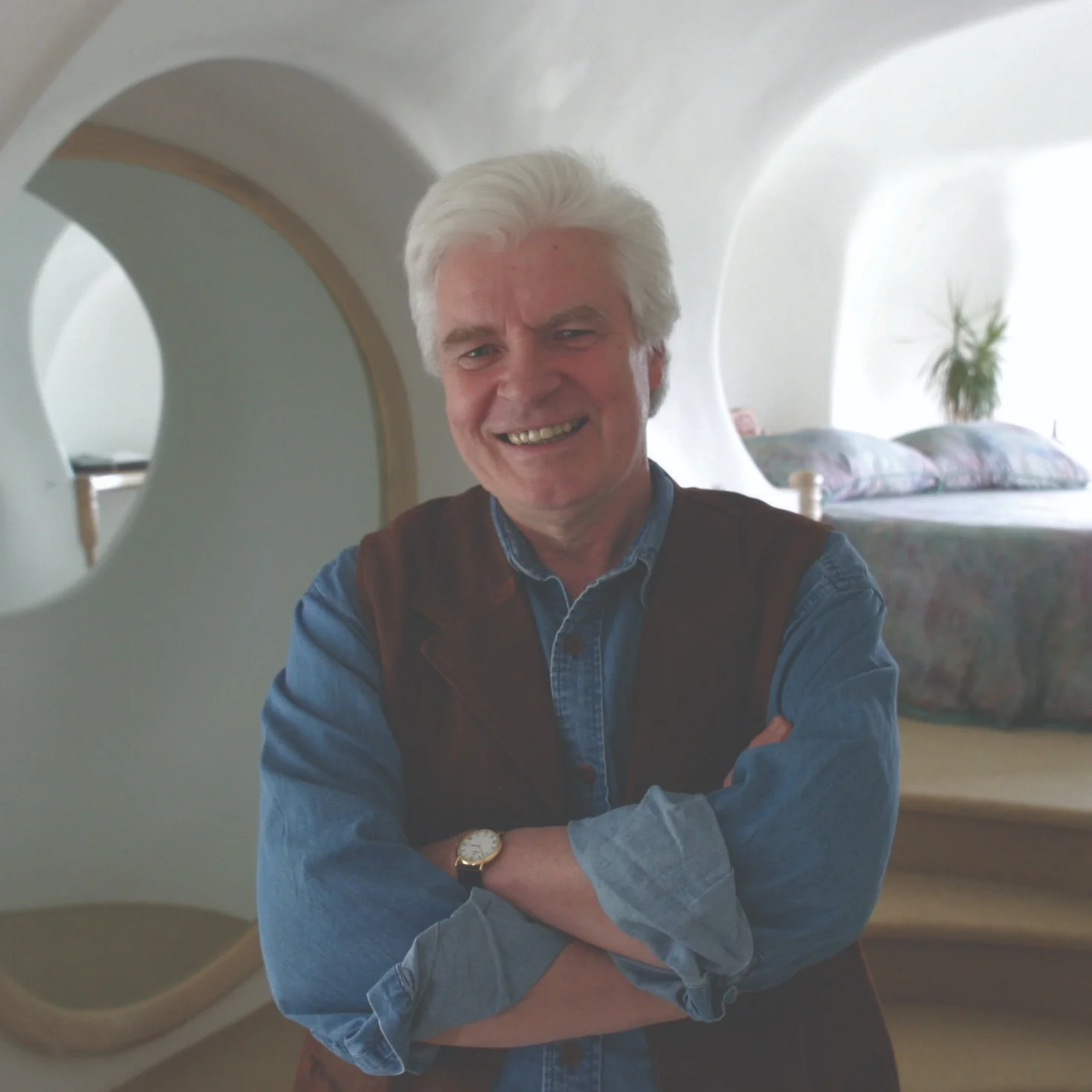ROGER DEAN
Designer & Architect of the Future
Inspired by both Chinese landscape art and feng shui as well as the psychedelic art style of Rick Griffin as a young man, Dean attended the Canterbury College of Art, and studied design and the “psychology of architecture” at the Royal College of Art in London. Among his first accomplishments was designing a “sea urchin” chair (considered the predecessor to the bean bag chair), now part of the permanent collection at the Victoria and Albert Art Museum, as well as the logos for both Fly and Virgin Records in the early 1970s.
Dean works primarily with watercolor paints, creating dreamy, ethereal scenes that have sold more than sixty million copies worldwide. In a career spanning six decades, he has created other-worldly images for bands including Pink Floyd, The Gun, Osibisa, Budgie, Uriah Heep, Gentle Giant, and others. Dean’s award-winning concepts have gone on to inspire design elements in films such as A Clockwork Orange and Avatar, appeared in numerous videogames, and he has published multiple books. Retrospective exhibitions of his artwork have been held in multiple galleries and museums, including the Victoria and Albert Art Museum, the Royal Academy, and the Royal College of Art. In 2002, Dean received an honorary doctorate from San Francisco’s Academy of Art University, and an honorary fellowship from the Arts University Bournemouth in 2009.
Throughout Dean’s work as an architectural illustrator, his research has always been what makes people feel comfortable in buildings. His Master’s thesis is about “producing a sense of tranquility in domestic architecture” and his focus has been designing for the future; homes that people will feel comfortable living in — on this world or another.
INTERVIEW WITH ROGER DEAN
What are your thoughts on the plans to construct a facility on the Moon?
I think it’s a brilliant and very timely project. But there are many physical challenges for designers and engineers building on the moon from local regolith, including dangerous radiation, a huge range of temperatures, micro meteorites, moonquakes, and a sixth of Earth’s gravity to contend with.
A more subtle but nevertheless serious concern is for the mental health of inhabitants. If a prisoner were to be put in a metal cylinder and placed in outer space or at the bottom of the ocean, there would be outrage for what would be considered “cruel and unusual” punishment. Similarly, a proposed MoonBase facility should be designed in such a way as to contribute to the mental and physical well-being of inhabitants.
With regards to the psychology of architecture, what should architects be mindful of when imagining future possible living and working spaces for human beings?
It’s likely that the best solution to many of the physical challenges is to build underground. That being said, people are not machines to be stored. It’ll be critical for occupants to have a viewing tower of some sort, to see their outside environment. The underground habitat will have to provide as much space as possible and I’d suggest the accommodation units be spread around a central space where they can each ‘look’ in. This central area should also contain as many natural features from Earth as possible, such as some sort of garden or with Zen elements.
As an artist and architect who has spend the past few decades imagining what the future might look like, are things improving or getting worse? Has your mental image of “tomorrow” changed from when you began designing in the 1960s to the present day?
When I was a child, I remember living with the threat of a 4-minute warning before a nuclear attack. When I started college, Rachel Carson’s Silent Spring made us all think we would die within a few years from chemical poisoning. A little later, we were all told that within seven years, the population would grow to the extent that it would overtake the planet’s ability to feed everyone and there would be food wars. Now we have global warming and giant asteroids; all perfectly real problems, but ultimately solvable. I believe that hope and optimism are much more powerful engines for change than pessimism and fear.
One of the things I’d like to say to children out there who are about to go into the world and start a career and have a family, is that I’m convinced that they’re going to grow up in, and bring their children into, a world that is far better than ours. In spite of global warming and terrorism and pollution with chemicals everywhere — in spite of all that, their world will be a better place than it is today. That’s pure science; there will be abundant water and food, systems to sequester carbon, and much more. The technology exists now, the challenge is political and how to get it out there. The question is, what kind of contribution can design make to give us a better world, too?
I’d say to begin with undoing the damages done from modern architecture, which has let us down very badly particularly since the Second World War.
How so? What are designers and architects doing incorrectly or poorly?
I think the brutal, oppressive blandness of a lot of modern architecture has become really damaging. It’s depressing and induces a lot of stress for both the people who live in it and those who live and work around it.
The job of design is to make the human entry into the world as benign as possible. Everything we build has to be much better, kinder, and more humane. Often, design reflects a view of humanity as anonymous in every sense other than our mechanical function; our homes, schools, hospitals, places of work, even churches, are designed in a bland, indistinguishable, interchangeable style, all very depressing and oppressive.
At its pinnacle, good design is wonderful and adds to everyone’s quality of life. So yes, design matters. And getting it wrong matters terribly.
Design or architecture? Or does accomplishing one poorly affect the other?
I think one bad architect can do more wrong than a thousand bad [graphic] designers. And I think the opposite is true, that one good architect can do more good than a thousand designers because of the sheer scale of what architects do. However, graphic design well done can carry a powerfully inspirational message that can change things. And in a broader sense, anything that focuses attention on design is good; design can be incredibly important and useful. So the more attention given to the subject, the better. If people are being trained and educated on design, they may go out and become great designers. But even if they’re not, the fact that they’ve been educated is useful.
We make objects, we recycle, and we can remake them. The problem is not making things and consuming them. The problem is designing things that are bad. And it doesn’t matter if it’s poorly designed cups or plates because those things can be recycled and they’re gone. The problem comes in the form of buildings; that’s really where we have to focus and we have to be tough about it.
Your artwork depicts a variety of natural-inspired architecture and alien landscapes. How did you get involved with music and how were you able to combine these seemingly separate interests?
It was just good fortune that I began working in the music industry while it was changing. What always fascinated me was that when you gave music, that 12” album was a fantastic gift. And it came with art; I was enthralled by that. Both music and art are gift cultures. Which doesn’t mean that they’re free but that they make great gifts. When I design album covers, I frequently try out architectural ideas, it’s a great way to demonstrate them.
Clients usually ask me three questions: will the public like it, is it possible to build, and if we build it, will it cost the Earth? Over the years, I’ve been able to show that somewhere between 60 and 100 million examples of my work have sold as posters, cards, books, album covers, and so on. I’ve worked with engineering firms who have said yes, these designs can be built, for this amount of money. So I can go back to clients and say, it can be built, built economically, and the public reaction is very positive.
When I started in music, many musicians were working to create alternative worlds and being part of that creative process was lovely. I think it was inspirational to a lot of people, and turned minds onto possibilities that they otherwise might not have had.
How important is good design in regards to the natural world?
I think that we, as a species, have been dropped into paradise and with building all our stuff, we stand a terrible chance of making an ugly mess of it. This is not inevitable, smart design is the tool with which we mess it up less. It offers a chance for human beings to be less in conflict with nature and to live in harmony with it.
We must take much more seriously our role of being guardians and the gardeners of the world. The responsibility of design is to make the world a better place. We don’t need to assert with brutal geometry that humans are here. The [Ancient] Greeks did it more elegantly, but their motivation was to say that within the wilderness, human beings were able to build something of our own. In today’s world, the wilderness itself is something we have to preserve.

